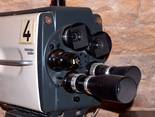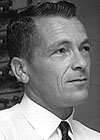Zum Auffrischen und Erinnern . . . .
. . . sind diese Seiten hier gedacht, denn viele wissen nicht mehr oder noch nicht, wie es damals angefangen hat und wie das wirklich funktioniert mit dem Fernsehen, den Kameras, den Videorecordern, den Tonband- und den Magnetband- geräten aus alter Zeit. Viele Bilder können Sie durch Anklicken vergrößern.
Die Charles P. Ginsburg Story - in englischer Sprache
DEVELOPMENT OF THE FIRST Video Tape Recorder by Geroge Boardman / Ampex (written 1982)
Videotape recording is so widespread and commonplace today, it is difficult to believe the technology astounded television broadcasters and created a multi-billion dollar industry just 25 years ago.
But in April 1955, the ability to broadcast from tape stirred pandemonium among the viewing audience and revolutionized the television industry. The event climaxed four years of work by a six-man team at Ampex Corporation; that would not give up its dream of recording television pictures on magnetic tape.
The story of how that dream came true started in 1951 with the arrival of Charles P. Ginsburg at Ampex. Ginsburg, now vice president (advanced technology planning), joined the Redwood City, Califorpia, firm for the express purpose of putting pictures on tape.
At the time of Ginsburg's arrival, Ampex made professional audio tape recorders for radio broadcasters and recording studios. But it didn't take much business acumen in the early '50s to realize that recording pictures on tape with the same ease and versatility with which sound was being done would lead to a large pot of gold at the end of the rainbow.
While the prize was obvious, the path to it was strewn with so many technical roadblocks that only the rich or foolhardy could pursue it. Two affluent organizations (RCA in the U.S. and the BBC in England) were committing skilled staff and healthy budgets to developing high speed videotape recorders if only to prove that pictures could be put on tape. The machines worked to some degree, but they gobbled up thousands of feet of tape in a few minutes and were commercially impractical.
While Ginsburg and his team were quietly experimenting with rotary head principles (the tape moves slowly and a magnetic head revolves rapidly), singer Bing Crosby also recognized the financial potential and set up his own experimental group in Hollywood.
Fortunately for Ampex, this well equipped and amply funded group also went the route of fixed heads and high speed tape, a blind alley that was eventually to be abandoned by everyone when the first Ampex videotape recorder was introduced in April 1956.
.
What was so difficult about developing a VTR?
What was so difficult about developing a VTR? Surrounded now by a gamut of tape machines of all sizes and shapes, it seems in retrospect that it must have been easier than it was.
In the late '40s, high fidelity audio tape recording was still a technical achievement of some novelty. While our ears need only 15,000 cycles per second to hear satisfactorily, our eyes demand at least 4 million cycles per second for acceptable pictures and no known magnetic mechanism of that era could even come close to that figure.
Ampex explored the idea of departing from narrow (1/4" wide) tape moving over stationary magnetic heads and trying wider (2" wide) tape moving relatively slowly (15" per second) past rapidly revolving heads.
After some early experiments that were disappointing, Ginsburg was fortunate to encounter a part-time Ampex employee and college student, Ray Dolby, whose interest and dedication to the early video recording attempts led to some measure of success.
By November of 1952, Alexander M. Poniatoff, the company founder, thought it appropriate to issue a memo attesting to a witnessed video tape playback whose spectators were himself, Ginsburg, Dolby and the company's patent attorney. He commented in the memo that this was being done in case of future patent problems, a prophetic statement in view of the subsequent scramble to patent other VTRs around Ampex's original creation.
Ampex was neither large nor wealthy enough at that time to assign unlimited priority to what was then called the TVR project. But that didn't prevent Ginsburg and Dolby from living and breathing the dream of committing pictures to tape.
In 1953 Ginsburg convinced management to spend a few more precious hours and dollars. The results were promising enough to increase the development team to six people, including engineers Charles Anderson, Alex Maxey and Fred Pfost. The final member was Shelby Henderson, a machinist, who built and designed the mechanical components.
The group faced some difficult problems. In 1954, no tape manufacturer made a suitable tape, no magnetic heads worked at the desired frequencies, no signal systems could cope with the fluctuations from poor tape, and no motors rotated smoothly enough to make stable images.
.
The list of secondary problems was endless
The list of secondary problems was endless, and most agonizing was the inter-dependency of the solutions; curing one thing often upset something else. The task was split up so that each man worked on his area of interest and expertise. While there was a high team spirit and endless effort toward their mutual goal, there were also some low psychological valleys when announcements of imminent success came from RCA or the Crosby organization.
But the group maintained its optimism by reading the fine print in the news releases (zwichen den Zeilen lesen); there were still a few minor technical details to clean up, like getting more than a few minutes of playing time from a reel of tape three feet in diameter.
Ginsburg is credited by his colleagues for not only the concept but, more importantly, for maintaining the momentum of the project in the face of seemingly unattainable objectives. Each team member worked with patience and precision to break the bottlenecks: switching, the FM signal system idea, the miniscule magnetic head assemblies, and the dynamics of tape scanning to build a basic system that has held for 25 years.
.
April 14, 1956, a meeting of 200 CBS affiliates in Chicago
The fruits of their labors became apparent April 14, 1956, when the first videotape recorder was demonstrated at a meeting of 200 CBS affiliates in Chicago. The audience of TV engineers and station managers, realizing they were witnessing history, stood up, stamped, cheered and whistled their approval.
The National Association of Radio and Television Broadcasters convention followed that demonstration, and Ampex left the convent with orders for $4 million worth of its magnetic miracle.
Today, the worldwide broadcast industry has absorbed well over $1 billion worth of high quality VTRs and accessories for TV program origination, sophisticated editing, slow and stop or reverse action, and all the other unique effects that are daily fare on the airwaves.
Ampex has built and sold the major portion of these VTRs and in the process has grown into a $500 million a year corporation with nearly 13,000 employees and offices in every corner of the video world.
.


